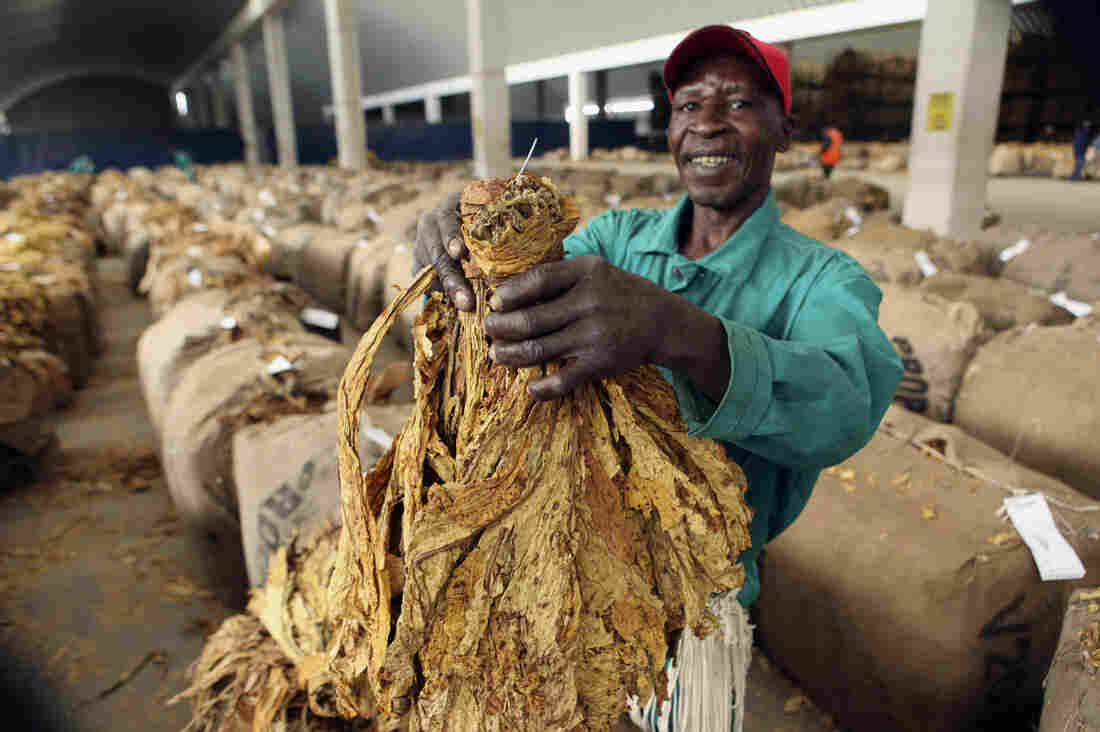A worker at Boka Tobacco auction floors displays some of the tobacco crop, in Harare, Zimbabwe, Tuesday May 14, 2013. The country’s tobacco selling season kicked off in February and to date tobacco worth over $400 million dollars has been sold to buyers mostly from China and the European Union. Tsvangirayi Mukwazhi/AP hide caption
itoggle caption Tsvangirayi Mukwazhi/AP
Noisy trolleys roll bales of tobacco on and off the auction floors in Harare, Zimbabwe’s capital. Here they call it “green gold.” Some of the country’s estimated 100,000 small-scale tobacco farmers look on, hoping for profitable sales.
Auctioneers, quoting prices at high speed, pace up and down rows of extra-large jute-covered bundles, with yellow tobacco leaves spilling out.
Closely behind the auctioneers follow the tobacco buyers. They indicate interest with a wink, a nod, two fingers up, eyes closed and all manner of gestures.
Celani Sithole is an auctioneer and floor manager at TSF — Tobacco Sales Floor — in Harare.
“Our standard sale speed is supposed to be five seconds per bale,” she says.
Sithole says they’re pushing through 7,000 to 8,000 bales a day. Farmers get their money the day their tobacco is sold.
“As soon as the bales are sold, before arbitration, the farmer has the right to cancel the bale or accept the price,” says Sithole.
What we’re witnessing on the auction floor is a far cry from just a few years ago. Output of most crops, including tobacco, dropped dramatically when President Robert Mugabe’s followers violently drove white farmers, the backbone of the economy, from their industrial-sized farms, starting in 2000.
The government handed the annexed land to black farmers, many of whom had little or no experience. The result was disastrous and the economy collapsed in a spiral of hyperinflation.
Once the breadbasket of southern Africa, Zimbabwe began importing food.
Tobacco production also suffered. Export earnings fell from $600 million in 2000 to $175 million in 2009.
But tobacco output jumped 235 percent last year, compared with 2009.
The CEO of the Tobacco Industry and Marketing Board, Andrew Matibiri, says production has rebounded.
“It’s back to normal almost,” he says. “In terms of world production, we’re nowhere near the top — but we’re probably at number two or number three, after Brazil and the United States.”
Matibiri says farming was especially hard-hit, in part because unlike the industrial white farmers who were landowners, Zimbabwe’s new black farmers are leaseholders and couldn’t get credit or bank loans without title deeds. So the tobacco sector and private companies stepped in with a new scheme. They contract with tobacco growers to produce the crop, providing fertilizers and chemicals.
Taizivei Chitaunhike is one of those farmers. The mother of four received her five-hectare farm from the government in 2003. She smiles shyly as she describes how her fortunes changed when she became a contract farmer two years ago.
“If you grow with contractors, you will manage to do all the things that you like on your farm,” she says. “The amount of capital that they give me helps me. For sure, I’m now much better for farming production. Tobacco is much better, because I manage to do all my budgets on my farm, we manage to pay school fees, labor, get food and other things.”
Chitaunhike says she has been up to the auction floors three times this selling season, with almost 25 bales of tobacco, and is getting good prices.
Sitting close by, under a young jacaranda tree, and listening attentively to Chitaunhike, is another tobacco farmer, Milca Matimbe. She’s 53 and got her 27-hectare farm ten years ago. Matimbe has been growing tobacco for five years but does not have a contract with a company. She sells independently and is disappointed with sales this season.
“The prices are not so good for us,” she says. “Last year it was better than this year, because the prices are not going up, they’re going down. Ah but we have got good tobacco. We don’t know if we can go back to the fields this coming season, because we’ve got no money.”
Zimbabwe consumes only a fraction of its tobacco output. Tobacco marketing board CEO Matibiri says the flue-cured tobacco is top quality, much prized and expensive. Forty percent of exports go to China, followed by the European Union and South Africa.
“We produce a premium product, which is in demand the world over,” he says. “It is said to have very good blending properties. In other words, it mixes very well with lower quality tobaccos produced in other parts of the world, producing nice, very pleasant cigarettes to smoke, if you’re a smoker – yeah.”
Back on the auction floor, brisk tobacco selling continues. It appears the banks are listening. The Bankers Association of Zimbabwe looks set to lend a billion dollars to agriculture this year — the lion’s share going to tobacco farming.
This entry passed through the Full-Text RSS service – if this is your content and you’re reading it on someone else’s site, please read the FAQ at fivefilters.org/content-only/faq.php#publishers.
